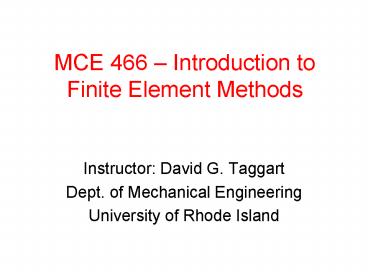MCE 466 Introduction to Finite Element Methods - PowerPoint PPT Presentation
1 / 18
Title:
MCE 466 Introduction to Finite Element Methods
Description:
Dept. of Mechanical Engineering. University of Rhode Island. Introduction ... Early 50's digital computers which solved large systems of equations became available. ... – PowerPoint PPT presentation
Number of Views:338
Avg rating:3.0/5.0
Title: MCE 466 Introduction to Finite Element Methods
1
MCE 466 Introduction to Finite Element Methods
- Instructor David G. Taggart
- Dept. of Mechanical Engineering
- University of Rhode Island
2
Introduction
- Finite Element Method a numerical method for
obtaining approximate solutions to field problems - Field Problems A problem in which the behavior
in a well defined region, R, is described by a
governing set of differential equations with
certain quantities prescribed on the boundary, C.
(Also called a boundary value problem BVP)
3
Introduction (cont.)
- Boundary Value Problem
- Examples
- Stress analysis (includes system of springs, bars
under axial loads, trusses, beams, frames, 2-D
3-D continua, plate bending) - Stability analysis (buckling), structural
dynamics, plasticity, viscoelasticity - Heat transfer
- Fluid flow
- General PDE problems
4
Finite Element Approach
- Divide the region into may discrete sub-regions
(discretization) of finite size (elements).
Select certain points (nodes) at which the
solution is desired. Assume a functional form
for the solution between the nodes (interpolation)
5
Important points to remember
- Finite element analyses provide approximate
solutions in nearly all cases - Results can be very accurate or totally
meaningless (easy to make mistakes) - Method is very susceptible to user error
- Stress averaged results may conceal inaccuracies
in the results - Modern commercial codes make it very easy to get
answers - Responsibility of user
- Anticipate results (perform approximate
calculations by hand) - Explain discrepancies
- Be aware of limitations
6
MCE 466 Course Structure
- Appropriate balance of FEA theory and use of
commercial codes (primarily Abaqus) - Text problems hand calculations with support of
Matlab as needed - Several Abaqus - based computer assignments
- Project individual or teams of 2
7
History of Finite Elements
- 1943 R. Courant (mathematician) proposed a
torsion solution using triangular subregions (not
implemented since no computers were available) - Early 50s digital computers which solved large
systems of equations became available. Aerospace
companies bega solving structures problems
(mostly unpublished) - 1960 term Finite Element Method first coined
- Early 60s new elements formulated, method
became accepted - Mid 60s Applied to heat transfer and fluid
flow problems - Late 60s, early 70s large general purpose
programs became commercially available (NASTRAN,
ANSYS, SAP) - Early 80s Interactive graphics made using FEA
easier - Late 80s Inexpensive PC versions became
available - 90s and beyond Widespread application in
numerous industries, Integration with CAD
packages. - Most recent emphasis multiphysics event
simulation
"Concepts and Applications of Finite Element
Analysis," by R. D. Cook, D. Malkus and M. Plesha
8
Review Matrix Algebra (see Appendix A, B)
- We will see that the finite element method
requires solving large systems of linear
equations using matrix algebra tools. - First, review matrix multiplication
- In general
9
Review Matrix Algebra (see Appendix A, B)
- To review some basic matrix algebra, consider the
following system of equations - or
10
Matrix Algebra (cont.)
- Matrix form
Matlab output a 2 1 1 4 b
6 17 determinant 7 solution
1.0000 4.0000
Matlab code a2 11 4 b617 determinantdet(
a) solutiona\b
Note a ? 0
11
Matrix Algebra (cont.)
- Now consider a different system of equations
or
12
Matrix Algebra (cont.)
Matrix form
Matlab code
Matlab output
a4 22 1 b166 determinantdet(a) solution
a\b
a 4 2 2 1 b 16
6 determinant 0 Warning Matrix is
singular to working precision. solution
Inf -Inf
Note a 0
13
Matrix Algebra (cont.)
- System of three equations (Matlab format)
- Code
- a-1 1 23 -1 13 3 1
- b262
- solutiona\b
- Output
- a
- -1 1 2
- 3 -1 1
- 3 3 1
- b
- 2
- 6
- 2
14
Matrix algebra applied to FEA
- For displacement based stress analysis
15
Other matrix terminology
- Banded matrix
- If all non-zero terms are contained within a band
along the diagonal, the matrix is said to be
banded - Sparse matrix
- If a matrix has relatively few non-zero terms (as
is common in FEA), the matrix is said to be
sparse - Singular matrix
- If the determinant of the matrix equals zero, the
matrix is said to be singular. As we saw, if A
is singular, then the system of equations
Axb has no unique solution.
16
Other matrix terminology (cont.)
- Transpose
- The transpose of a matrix is found by
interchanging rows and columns, e.g. - Transpose of a product
17
Steps in the Finite Element Method
- Discretize the region and select element type
- Select a displacement function
- Define the strain/displacement and stress/strain
relations - Derive the element equations
- Direct Stiffness Method
- Energy Methods
- Method of Weighted Residuals (Galerkins method)
- Assemble global equations and impose boundary
conditions - Solve for unknown nodal displacements
- Solve for element strains and stresses
- Interpret results
18
Demo of a Commercial FEA Package
- Determine maximum stress for the following
problem































